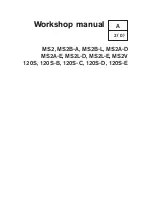
7
General instructions
Torque-angle tightening
In torque/angle tightening, the fastener is tightened to
the specified torque, and tightening then continues
through a pre-determined angle. Example: for 90° an-
gle tightening, the fastener is turned a further 1/4 turn
in one sequence, after the specified tightening torque
has been achieved.
Lock nuts
Disassembled locknuts shall not be re-used, they
shall be replaced by new ones, since the locking prop-
erties are impaired or lost when the nut is used sever-
al times. On locknuts with plastic inserts, such as Ny-
lock
®
, the tightening torque specified in the table must
be reduced if the Nylock
®
nut has the same nut height
as a standard fully metallic hexagonal nut. Reduce the
tightening torque by 25% if the screw dimension is 8
mm or greater. On Nylock
®
nuts with higher nut
height, where the fully metallic thread is as high as on
a standard hexagonal nut, use the tightening torques
in the table.
Strength classes
Screws and nuts are sub-divided into different
strength classes. Classification is indicated by mark-
ings on the screw head. A marking with higher number
indicates stronger material. For example, a screw
marked 10-9 is stronger than one marked 8-8. For this
reason, when fasteners are removed, it is important
that the screws are put back in the correct places
when they are re-installed. When you change screws,
please check the spare parts catalogue to ensure that
the correct versions are obtained.
Tightening torque
The tightening torques for vital fasteners, which
should be tightened with a torque wrench, are listed in
“Specifications: Tightening torque” and noted in the
job descriptions in the book. All torque specifications
apply to clean screws, screw heads and mating faces.
The torque specifications apply to lightly oiled or clean
screws. If lubricants, locking fluids or sealants are
needed on a fastener, the type of preparation to be
used will be noted in the job description and in “Tight-
ening Torques”. Where a particular torque value is not
specified for any fastener, the general tightening
torques in the table below shall apply. The torque
specification is a target value and the fastener does
not need to be tightened with a torque wrench.
Dimension
Tightening torque
Nm
lbf ft
M5
6
4.4
M6
10
7.4
M8
25
18.4
M10
50
36.9
M12
80
59.0
M14
140
103.3
Содержание 120S
Страница 2: ......
Страница 16: ...14 Design and function Reverse gear MS2 Forward position Reverse position ...
Страница 17: ...15 Design and function Sailboat drive 120S Forward position Reverse position ...
Страница 85: ...83 References to Service Bulletins Group No Date Refers to ...
Страница 86: ...84 Notes ...
Страница 88: ...7752950 1 English 01 2001 ...










































